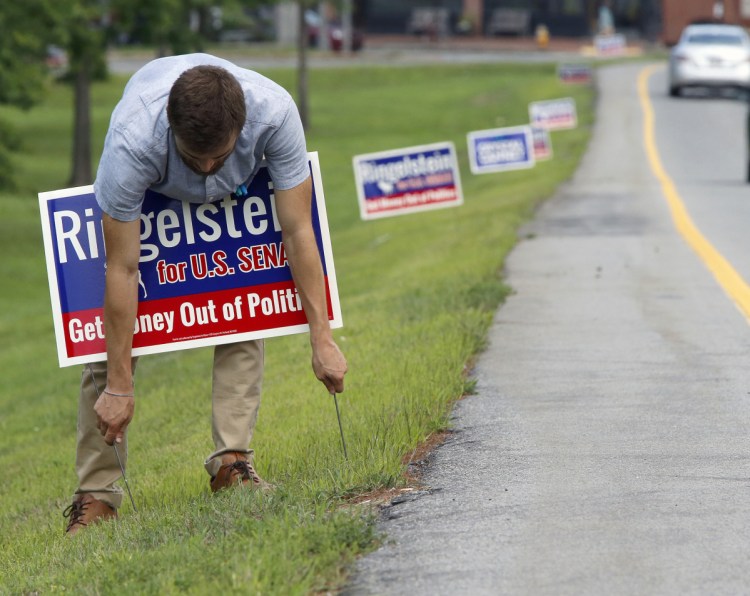Love them or hate them – you’re probably going to see campaign signs go up earlier and stay up longer.
That’s because a state law change that went into effect Aug. 1 allows temporary signs to be placed in the public right of way for 12 weeks a year, twice as long as previous limits. That means Mainers may be stuck seeing campaign signs for nearly a quarter of the year.
“You can put a temporary sign in the public right of way for 12 weeks between Aug. 1 and Dec. 31, and then next year it will be 12 weeks for the calendar year,” said Toni Kemmerle, an attorney with the Maine Department of Transportation, which is charged with enforcing sign rules along state highways. Commercial business signs fall under different regulations, she said.
The law change was intended to help farmers advertise produce markets, not so much to extend the campaign season. But the side effect irks people like Debbie Donaldson, who passed by campaign signs recently planted in a grassy expanse separating the lanes on Franklin Street in Portland. The 63-year-old initially said campaign signs were generally “fine by me.” But her opinion changed when she was told about the recent law change.
“Oh, God, no!” Donaldson said. “I think it should only be for a short amount of time before the election. This whole area is going to be loaded.”
FORGING AHEAD, HOLDING BACK
The first campaign signs along Franklin Street – one of the city’s most popular spots for sign planters – belong to Crystal Canney, a communications professional who is running as an independent for the District 27 seat in the state Senate against Democratic incumbent Benjamin Chipman. Her blue signs are placed in succession on the arterial connecting Interstate 295 to the waterfront.
Canney appeared to be the first candidate in Portland to take advantage of the new rules, although later Thursday someone was spotted planting signs for Democrat Zak Ringelstein, who is challenging independent Angus King for the U.S. Senate.
Canney said she heard about the law change and got confirmation from the MDOT before placing the signs, which she said are needed to build name-recognition against an incumbent. Canney’s signs generated some complaints to the city, which the candidate chalked up to her opponent’s supporters.
“While this story about campaign signs has gotten some attention from my opponent and his surrogates, I would hope we could get to a point that we talk about the issues that are important to the Maine people,” said Canney, expressing an eagerness to debate Chipman. “I care deeply about where our state goes and I care deeply about Portland.”
Chipman said he knew about the change and has chosen to wait before putting up signs.
“Every year, Halloween candy, pumpkin spiced lattes and other things come out earlier and earlier. I, for one, don’t think campaign signs should join that trend,” Chipman said. “Much like Halloween candy and pumpkin spiced coffee, I think campaign signs should wait for the fall.”
IT ALL STARTED WITH FARMERS
The new rules have been several years in the making.
The Maine Legislature first amended its rules governing temporary signs to comply with a 2015 U.S. Supreme Court ruling in the case of Reed vs. the Town of Gilbert, Arizona. The ruling said regulations applying to signs advertising religious services cannot be more strict than rules for political signs.
At the time, Maine’s laws allowed political signs to be placed on public rights of way within six weeks of an election and within one week after. To comply with the court ruling, the Legislature amended the law to encompass all temporary signs, allowing them to be installed for up to six weeks a year along public ways.
But that change ensnared local farmers, who rely on temporary signs to advertise farm stands for produce, blueberries and pick-your-own apples. They argued that a 42-day limit was too restrictive. So last session, at the urging of farmers, the Legislature acted on a bill to lengthen the time for all signs to 12 weeks, or 84 days, a year.
As it turned out, loosening the rules to help farmers also helped sign-savvy politicians.
Portland City Clerk Katherine Jones said Thursday that she was in the process of informing the City Council about the rule changes. So far, Jones has only received complaints and questions about Canney’s signs.
Jones wondered how the new 12-week limit would be enforced, especially when there is both a primary and general election in one calendar year.
“Who’s going to document and keep track of those signs?” Jones asked.
ARE POLITICAL SIGNS EFFECTIVE?
Each sign is supposed to contain the name and address of the person who planted it, along with the date on which it was planted. Kemmerle said the city would be responsible for enforcing rules on local roads, while the state would only enforce the rules for state and state-owned roads.
“We mainly respond to complaints,” said Kemmerle, noting that any sign that presents a safety hazard is promptly removed.
West End resident Rosanne Graef, who supports Chipman, said she is unhappy with the new rules. She said politicians who think planting more signs for longer periods of time will translate into more voters should think again – especially if those signs are made out of plastic, which Canney’s are not.
“It’s such a waste of resources,” Graef said. “Portland is such a lovely city, except this time leading up to elections.”
She added, “If a candidate thinks that’s what gets their message out to voters, then they shouldn’t be running.”
Randy Billings can be contacted at 791-6346 or at:
rbillings@pressherald.com
Twitter: randybillings
Send questions/comments to the editors.



